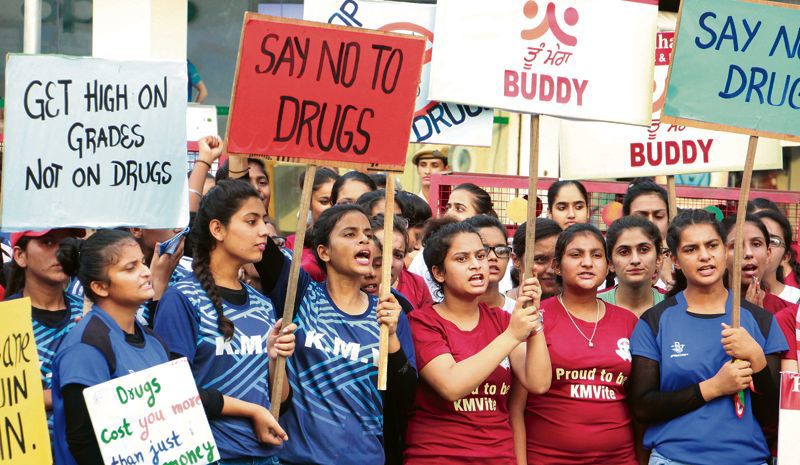Punjab must address root causes of drug abuse
PUNJAB has been grappling with a severe drug addiction crisis that has claimed many young lives. Unfortunately, the state lacks comprehensive data on drug addicts and related deaths, their socio-economic profiles, reasons for addiction and its socio-economic costs. A recent report in The Tribune, ‘Punjab drug overdose: 14 deaths in 14 days’, highlighted the government’s failure to curb this menace, indicating that the issue extends beyond overdose; it includes the threat of addiction and premature deaths among the youth. Alarmingly, adolescents are also falling prey to drug addiction. This necessitates a multi-pronged strategy that addresses the root causes of addiction, curbs drug supply and demand, promotes de-addiction and rehabilitation and prevents a rise in the number of drug users.
A recent study conducted by my colleagues Gurinder Kaur and Jatinder Singh and me at the Centre for Research in Rural and Industrial Development (CRRID), Chandigarh, and commissioned by the Indian Council of Social Science Research (ICSSR), New Delhi, titled ‘Dynamics of Drug Addiction and Abuse in India, with a Major Focus on Punjab’ (Routledge, 2024), delves into the socio-cultural and politico-economic reasons behind drug addiction. The study underlines the need to address the underlying causes comprehensively, in the absence of which sustainable solutions to Punjab’s drug menace will remain unattainable. It also reveals an unholy nexus among smugglers, police and politicians (SPP), as evidenced by the indictment of senior police officers and CM Bhagwant Mann’s reported admission of some cops’ involvement with smugglers, leading to the transfer of 10,000 personnel.
The distribution of intoxicants and drugs during elections further undermines the political will to combat the drug crisis. Successive governments have downplayed the issue. In 2009, an affidavit submitted to the Punjab and Haryana High Court wrongly claimed that 70 per cent of the state’s youth were addicted to drugs. The 2016 Hindi movie Udta Punjab magnified the issue, bringing national attention to it. The arrest of dismissed Punjab Police DSP Jagdish Singh Bhola in a multimillion-dollar drug racket in 2013 exposed the extent of the problem. Despite being a key election issue for over a decade, there has been little progress. Even the special task force (STF) reports on drugs, submitted to the high court in 2018, faced administrative and legal challenges, hinting at the SPP nexus.
Following The Tribune’s report, the Punjab Government declared another war on drugs. But such declarations have been made before, with little success. Measures like the constitution of the STF under the ADGP in 2017, the arrest of Bhola and a former Cabinet minister and the apprehension of thousands of peddlers and addicts were notable steps. The government also introduced outpatient opioid-assisted treatment, drug abuse prevention officers and buddy programmes. However, despite these efforts, the drug menace persists.
Our study also highlights the severe socio-economic ramifications of drug addiction, which burdens the health infrastructure and law enforcement while consuming the most productive years of human capital, leading to premature deaths from ailments like HIV/AIDS.
Punjab’s drug supply comes from international and domestic sources. The Golden Crescent (Iran, Afghanistan and Pakistan) and the Golden Triangle (Myanmar, Laos and Thailand) are major international sources, with Punjab situated on the transit route of the Golden Crescent. Additionally, opioid-based and synthetic drugs are manufactured and supplied domestically.
Economic factors contributing to drug use and peddling include high unemployment, underemployment, low wages and the lure of quick money from drug peddling. Among affluent households, easy access to money is a factor. Social factors include the consumption of intoxicants by elders, peer pressure, disharmonious family relations, unfulfilled aspirations, frustration, failure, the rise of nuclear families, shrinking community interaction and rising individualism and loneliness. Additionally, a lack of awareness about the harmful effects of drugs and an indifferent civil society exacerbate the problem. Politically, the SPP nexus remains a significant barrier.
Addressing the drug menace requires acknowledging that drug addicts are victims of deep-rooted socio-cultural and politico-economic distortions and should be treated as patients, not culprits. Along with the government’s three-pronged strategy of enforcement, de-addiction and prevention, emphasis must also be laid on rehabilitation and preventing relapse.
A holistic approach to tackling drug addiction in Punjab should include the following strategies:
(i) Establish a robust data collection system to gather comprehensive information on drug addiction, including socio-economic profiles, reasons for addiction and the socio-economic costs of addiction. This data will help targeted interventions.
(ii) Intensify efforts to dismantle the SPP nexus. Ensure strict enforcement of laws against drug trafficking and distribution, coupled with swift judicial action against offenders.
(iii) Expand and improve de-addiction and rehabilitation centres, ensuring that they are accessible and adequately staffed. Implement evidence-based treatment protocols and provide psychological and social support to recovering addicts.
(iv) Launch comprehensive campaigns targeting schools, colleges and communities to spread awareness about the dangers of drug use and the importance of seeking help.
(v) Address unemployment and underemployment by creating job opportunities and skill development programmes. Strengthen social support systems to mitigate the socio-economic factors contributing to drug addiction.
(vi) Encourage community involvement in combating drug addiction through local initiatives and support groups. Mobilise civil society organisations to advocate for policy changes and provide support to the affected families.
(vii) Collaborate with neighbouring countries to curb cross-border drug trafficking. Strengthen border security and intelligence-sharing mechanisms to intercept drug supplies.
(viii) Ensure inter-state cooperation, which would provide a real-time exchange of information and data, leading to an effective intervention.
By addressing the drug problem with a comprehensive and coordinated approach, Punjab can make significant strides in curbing drug addiction and its associated socio-economic costs. The war on drugs must be fought with determination, compassion and a commitment to systemic change.









